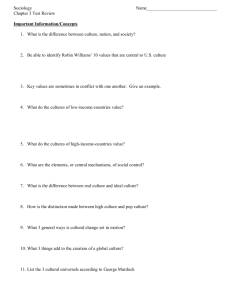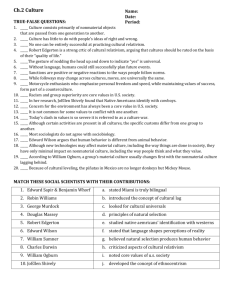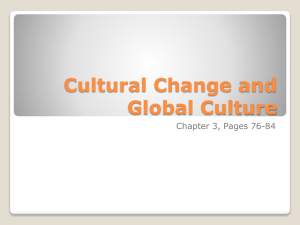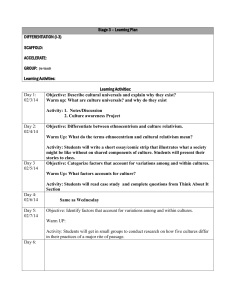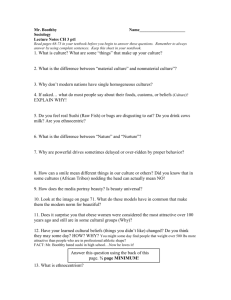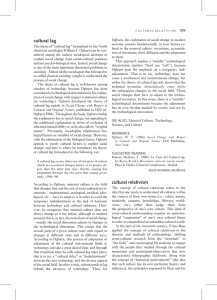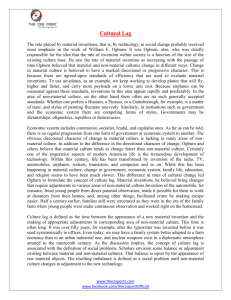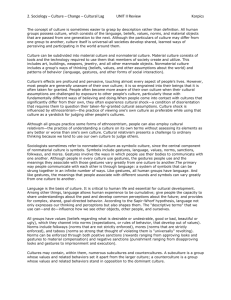CHAPTER 2 CULTURE
advertisement
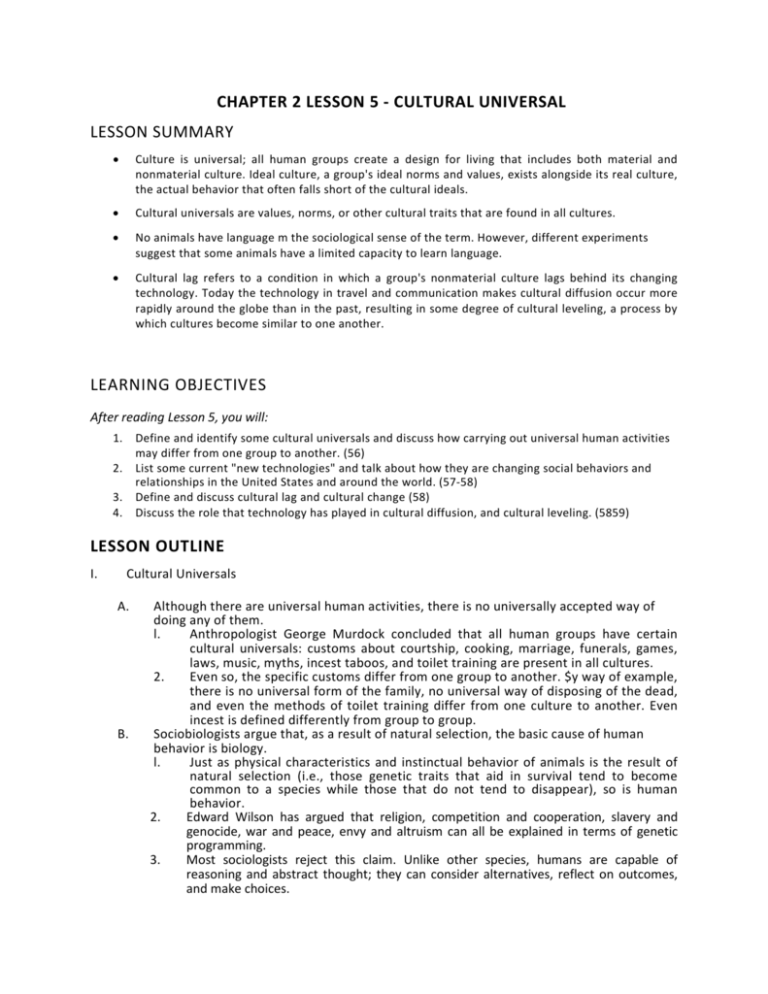
CHAPTER 2 LESSON 5 - CULTURAL UNIVERSAL LESSON SUMMARY • Culture is universal; all human groups create a design for living that includes both material and nonmaterial culture. Ideal culture, a group's ideal norms and values, exists alongside its real culture, the actual behavior that often falls short of the cultural ideals. • Cultural universals are values, norms, or other cultural traits that are found in all cultures. • No animals have language m the sociological sense of the term. However, different experiments suggest that some animals have a limited capacity to learn language. • Cultural lag refers to a condition in which a group's nonmaterial culture lags behind its changing technology. Today the technology in travel and communication makes cultural diffusion occur more rapidly around the globe than in the past, resulting in some degree of cultural leveling, a process by which cultures become similar to one another. LEARNING OBJECTIVES After reading Lesson 5, you will: 1. Define and identify some cultural universals and discuss how carrying out universal human activities may differ from one group to another. (56) List some current "new technologies" and talk about how they are changing social behaviors and relationships in the United States and around the world. (57-58) Define and discuss cultural lag and cultural change (58) Discuss the role that technology has played in cultural diffusion, and cultural leveling. (5859) 2. 3. 4. LESSON OUTLINE I. Cultural Universals A. B. Although there are universal human activities, there is no universally accepted way of doing any of them. l. Anthropologist George Murdock concluded that all human groups have certain cultural universals: customs about courtship, cooking, marriage, funerals, games, laws, music, myths, incest taboos, and toilet training are present in all cultures. 2. Even so, the specific customs differ from one group to another. $y way of example, there is no universal form of the family, no universal way of disposing of the dead, and even the methods of toilet training differ from one culture to another. Even incest is defined differently from group to group. Sociobiologists argue that, as a result of natural selection, the basic cause of human behavior is biology. l. Just as physical characteristics and instinctual behavior of animals is the result of natural selection (i.e., those genetic traits that aid in survival tend to become common to a species while those that do not tend to disappear), so is human behavior. 2. Edward Wilson has argued that religion, competition and cooperation, slavery and genocide, war and peace, envy and altruism can all be explained in terms of genetic programming. 3. Most sociologists reject this claim. Unlike other species, humans are capable of reasoning and abstract thought; they can consider alternatives, reflect on outcomes, and make choices. II. Technology in the Global Village A. Central to a group's material culture is its technology. In its simplest sense, technology can be equated with tools. In its broadest sense, technology also includes the skills or procedures necessary to make and use those tools. 1. The emerging technologies of an era that make a major impact on human life are referred to as new technologies. The printing press and the computer are both examples of new technologies. 2. The sociological significance of technology is that it sets the framework for the nonmaterial culture, influencing the way people think and how they relate to one another. B. Not all parts of culture change at the same pace; cultural lag was William Ogburn's term for situations where the material culture changes first and the nonmaterial culture lags behind. C. Although for most of human history cultures had little contact with one another, there has always been some contact with other groups, resulting in groups learning from one another. 1. This transmission of cultural characteristics is cultural diffusion; it is more likely to produce changes in material culture than the nonmaterial culture. 2: Cultural diffusion occurs more rapidly today, given the technology. 3. Travel and communication unite the world to such an extent that there almost is no "other side of the world." For example, Japan, no longer a purely Eastern culture, has adapted Western economic production, forms of dress, music, and so on. This leads to cultural leveling where cultures become similar to one another. KEY TERMS After studying the lesson, review the definition for each of the following terms. cultural diffusion: the spread of cultural characteristics from one group to another (58) cultural lag: William Ogburn's term for human behavior lagging behind technological innovations (58) cultural leveling: the process by which cultures become similar to one another and especially by which Western industrial culture is imported and diffused into industrializing nations (59) cultural universal: a value, norm, or other cultural trait that is found in every group (56) new technology: the emerging technologies of an era that have a significant impact on social life (58) KEY PEOPLE Review the major theoretical contributions or findings of these people. Peter Conrad: He notes that not all homosexuals have the Xq28, "gay gene," and some people who have this gene are not homosexual. This gene does not determine behavior and social causes should be examined. (57) Charles Darwin: Darwin studied the principles on which natural selection occurred. (57) George Murdock: Murdock was an anthropologist who sought to determine which cultural values, norms, or traits, if any, were found universally across the globe. (56) William Ogburn: Ogburn coined the term "cultural lag." (58) Edward Wilson: Wilson is an insect specialist who claims that human behavior is also the result of natural selection. (57)
